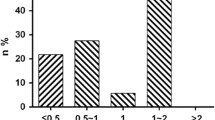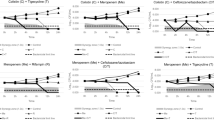Abstract
Fosfomycin represents a potential last-resort treatment option for infections with certain multidrug-resistant (MDR) Gram-negative pathogens. We evaluated double-drug combinations of fosfomycin with imipenem, meropenem, doripenem, colistin, netilmicin, and tigecycline for in vitro synergy against 100 MDR Klebsiella pneumoniae, Escherichia coli, and Pseudomonas aeruginosa clinical isolates, using the Etest method. Synergy was defined as a fractional inhibitory concentration index ≤0.5. The isolates were consecutively collected at a university hospital in Greece from various clinical specimens. Against 50 serine carbapenemase-producing K. pneumoniae isolates, synergy of fosfomycin with imipenem, meropenem, doripenem, colistin, netilmicin, and tigecycline was observed for 74.0%, 70.0%, 74.0%, 36.0%, 42.0%, and 30.0% of the isolates, respectively. Against 14 extended-spectrum β-lactamase (ESBL)-producing K. pneumoniae isolates, synergy of fosfomycin with imipenem, meropenem, doripenem, colistin, netilmicin, and tigecycline was observed for 78.6%, 42.9%, 42.9%, 7.1%, 42.9%, and 21.4%, respectively; for 20 ESBL-producing E. coli isolates, the corresponding values were 55.0%, 25.0%, 30.0%, 15.0%, 25.0%, and 25.0%; and for 15 MDR P. aeruginosa isolates, the corresponding values were 46.7%, 53.3%, 73.3%, 13.3% , 13.3%, and 13.3%. Antagonism was not observed for any of the combinations tested. Further studies are needed in order to confirm the clinical relevance of the above findings.
Similar content being viewed by others
References
Maviglia R, Nestorini R, Pennisi M (2009) Role of old antibiotics in multidrug resistant bacterial infections. Curr Drug Targets 10:895–905
Neu HC (1992) The crisis in antibiotic resistance. Science 257:1064–1073
Popovic M, Steinort D, Pillai S, Joukhadar C (2010) Fosfomycin: an old, new friend? Eur J Clin Microbiol Infect Dis 29:127–142
Roussos N, Karageorgopoulos DE, Samonis G, Falagas ME (2009) Clinical significance of the pharmacokinetic and pharmacodynamic characteristics of fosfomycin for the treatment of patients with systemic infections. Int J Antimicrob Agents 34:506–515
Falagas ME, Kastoris AC, Kapaskelis AM, Karageorgopoulos DE (2010) Fosfomycin for the treatment of multidrug-resistant, including extended-spectrum beta-lactamase producing, Enterobacteriaceae infections: a systematic review. Lancet Infect Dis 10:43–50
Falagas ME, Maraki S, Karageorgopoulos DE, Kastoris AC, Mavromanolakis E, Samonis G (2010) Antimicrobial susceptibility of multidrug-resistant (MDR) and extensively drug-resistant (XDR) Enterobacteriaceae isolates to fosfomycin. Int J Antimicrob Agents 35:240–243
Falagas ME, Giannopoulou KP, Kokolakis GN, Rafailidis PI (2008) Fosfomycin: use beyond urinary tract and gastrointestinal infections. Clin Infect Dis 46:1069–1077
Nilsson AI, Berg OG, Aspevall O, Kahlmeter G, Andersson DI (2003) Biological costs and mechanisms of fosfomycin resistance in Escherichia coli. Antimicrob Agents Chemother 47:2850–2858
Rodríguez-Rojas A, Maciá MD, Couce A, Gómez C, Castañeda-García A, Oliver A, Blázquez J (2010) Assessing the emergence of resistance: the absence of biological cost in vivo may compromise fosfomycin treatments for P. aeruginosa infections. PLoS One 5:e10193
Falagas ME, Karageorgopoulos DE (2008) Pandrug resistance (PDR), extensive drug resistance (XDR), and multidrug resistance (MDR) among Gram-negative bacilli: need for international harmonization in terminology. Clin Infect Dis 46:1121–1122
Farmer JJ 3rd, Boatwright KD, Janda JM (2007) Enterobacteriaceae: introduction and identification. In: Murray PR, Baron EJ, Jorgensen JH, Landry ML, Pfaller MA (eds) Manual of clinical microbiology. ASM Press, Washington, DC, pp 649–669
Paterson DL, Bonomo RA (2005) Extended-spectrum β-lactamases: a clinical update. Clin Microbiol Rev 18:657–686
Anderson KF, Lonsway DR, Rasheed JK, Biddle J, Jensen B, McDougal LK, Carey RB, Thompson A, Stocker S, Limbago B, Patel JB (2007) Evaluation of methods to identify the Klebsiella pneumoniae carbapenemase in Enterobacteriaceae. J Clin Microbiol 45:2723–2725
Lee K, Lim Y, Yong D, Yum J, Chong Y (2003) Evaluation of the Hodge test and the imipenem-EDTA double-disk synergy test for differentiating metallo-β-lactamase-producing isolates of Pseudomonas spp. and Acinetobacter spp. J Clin Microbiol 41:4623–4629
Queenan AM, Bush K (2007) Carbapenemases: the versatile β-lactamases. Clin Microbiol Rev 20:440–458
Clinical and Laboratory Standards Institute (CLSI) (2010) Performance standards for antimicrobial susceptibility testing; Twentienth informational supplement. CLSI Document M100-S20. CLSI, Wayne, PA, USA
White RL, Burgess DS, Manduru M, Bosso JA (1996) Comparison of three different in vitro methods of detecting synergy: time–kill, checkerboard, and E test. Antimicrob Agents Chemother 40:1914–1918
Odds FC (2003) Synergy, antagonism, and what the chequerboard puts between them. J Antimicrob Chemother 52:1
Kastoris AC, Rafailidis PI, Vouloumanou EK, Gkegkes ID, Falagas ME (2010) Synergy of fosfomycin with other antibiotics for Gram-positive and Gram-negative bacteria. Eur J Clin Pharmacol 66:359–368
MacLeod DL, Barker LM, Sutherland JL, Moss SC, Gurgel JL, Kenney TF, Burns JL, Baker WR (2009) Antibacterial activities of a fosfomycin/tobramycin combination: a novel inhaled antibiotic for bronchiectasis. J Antimicrob Chemother 64:829–836
Tessier F, Quentin C (1997) In vitro activity of fosfomycin combined with ceftazidime, imipenem, amikacin, and ciprofloxacin against Pseudomonas aeruginosa. Eur J Clin Microbiol Infect Dis 16:159–162
Daza R, Moreno-López M, Dámaso D (1977) Interactions of fosfomycin with other antibiotics. Chemotherapy 23(Suppl 1):86–92
Buisson Y, Bercion R, Mauclère P, Hugard L, Schill H (1988) Preliminary study of the antagonistic effects between fosfomycin and beta-lactams on Pseudomonas aeruginosa observed on the antibiogram. Pathol Biol (Paris) 36:671–674
Eliopoulos GM, Moellering RC Jr (1982) Antibiotic synergism and antimicrobial combinations in clinical infections. Rev Infect Dis 4:282–293
Skarzynski T, Mistry A, Wonacott A, Hutchinson SE, Kelly VA, Duncan K (1996) Structure of UDP-N-acetylglucosamine enolpyruvyl transferase, an enzyme essential for the synthesis of bacterial peptidoglycan, complexed with substrate UDP-N-acetylglucosamine and the drug fosfomycin. Structure 4:1465–1474
Grossato A, Sartori R, Fontana R (1991) Effect of non-beta-lactam antibiotics on penicillin-binding protein synthesis of Enterococcus hirae ATCC 9790. J Antimicrob Chemother 27:263–271
Totsuka K, Uchiyama T, Shimizu K, Kanno Y, Takata T, Yoshida T (1997) In vitro combined effects of fosfomycin and β-lactam antibiotics against penicillin-resistant Streptococcus pneumoniae. J Infect Chemother 3:49–54
Michalopoulos A, Virtzili S, Rafailidis P, Chalevelakis G, Damala M, Falagas ME (2010) Intravenous fosfomycin for the treatment of nosocomial infections caused by carbapenem-resistant Klebsiella pneumoniae in critically ill patients: a prospective evaluation. Clin Microbiol Infect 16:184–186
Nordmann P, Cuzon G, Naas T (2009) The real threat of Klebsiella pneumoniae carbapenemase-producing bacteria. Lancet Infect Dis 9:228–236
Daikos GL, Petrikkos P, Psichogiou M, Kosmidis C, Vryonis E, Skoutelis A, Georgousi K, Tzouvelekis LS, Tassios PT, Bamia C, Petrikkos G (2009) Prospective observational study of the impact of VIM-1 metallo-beta-lactamase on the outcome of patients with Klebsiella pneumoniae bloodstream infections. Antimicrob Agents Chemother 53:1868–1873
Takahashi K, Kanno H (1984) Synergistic activities of combinations of beta-lactams, fosfomycin, and tobramycin against Pseudomonas aeruginosa. Antimicrob Agents Chemother 26:789–791
Bonapace CR, White RL, Friedrich LV, Bosso JA (2000) Evaluation of antibiotic synergy against Acinetobacter baumannii: a comparison with Etest, time–kill, and checkerboard methods. Diagn Microbiol Infect Dis 38:43–50
Di Bonaventura G, Picciani C, Spedicato I, Piccolomini R (2004) E-test method for detecting antibiotic synergy against Pseudomonas aeruginosa from neutropenic patients: a cost-effective approach. New Microbiol 27:263–272
Giakoupi P, Maltezou H, Polemis M, Pappa O, Saroglou G, Vatopoulos A (2009) KPC-2-producing Klebsiella pneumoniae infections in Greek hospitals are mainly due to a hyperepidemic clone. Euro Surveill 14.
Funding
None.
Conflict of interest
None.
Transparency declarations
None to declare.
Author information
Authors and Affiliations
Corresponding author
Rights and permissions
About this article
Cite this article
Samonis, G., Maraki, S., Karageorgopoulos, D.E. et al. Synergy of fosfomycin with carbapenems, colistin, netilmicin, and tigecycline against multidrug-resistant Klebsiella pneumoniae, Escherichia coli, and Pseudomonas aeruginosa clinical isolates. Eur J Clin Microbiol Infect Dis 31, 695–701 (2012). https://doi.org/10.1007/s10096-011-1360-5
Received:
Accepted:
Published:
Issue Date:
DOI: https://doi.org/10.1007/s10096-011-1360-5




